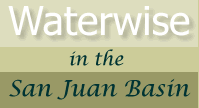| The
use of an appropriate mulch is an essential practice
in all successful xeriscapes. In general the definition
of a mulch is “any material which covers
the soil and reduces evaporation.” Mulches
also provide a number of additional benefits including:
1) Moderating the extremes of
moisture and temperature, and improving soil conditions
to allow better root development. Less water is
lost during periods of high temperature due to
evaporation, and the evaporation that does occur
helps to cool the soil. During periods of cold
temperatures, a good layer of mulch helps to buffer
the effects of freezing and wintertime moisture
loss.
2) Mulch also minimizes erosion
by absorbing and diffusing the force of rainfall
and irrigation water. Mulches act as a sponge
soaking up moisture and allowing it to penetrate
the soil more slowly rather than running off.
Mulch is especially useful on sloping sites to
slow runoff and hold soil in place.
3) Mulches are the first line
of defense against weeds. A good layer of mulch
will bury weed seeds and discourage germination.
Weeds that do germinate can more easily be removed
due to the loose texture of the mulch and the
higher moisture content of the soils below.
4) As mulch decomposes, it helps
to improve the top few inches of soil, adding
nutrients and organic material which allow water
to penetrate more effectively. |

